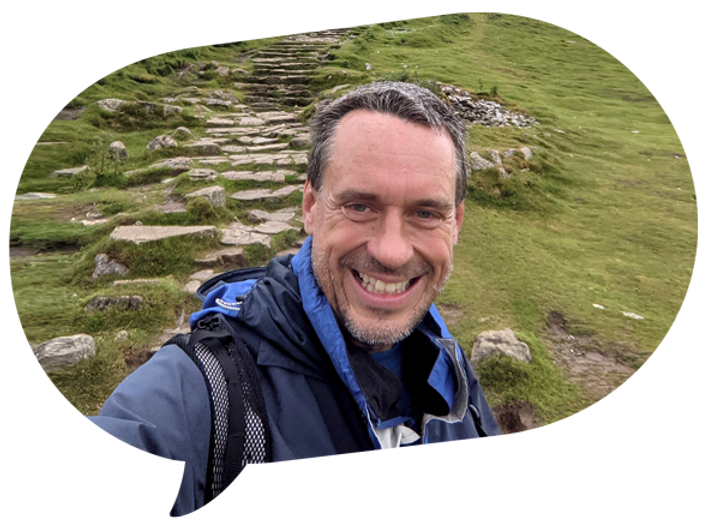My GP referred me to neurologist who at first diagnosed me with having CIDP – a rare autoimmune disease. For over a year, I went through regular drug infusions to treat it, but after some temporary relief, the therapy stopped working effectively.
That’s when I was referred to haematology, and was diagnosed shortly after with Waldenstrom’s macroglobulinaemia. My first reaction was to ask my consultant what WM was, to which he replied, “It’s cancer.” I don’t remember much of what the subsequent conversation was about; although he spoke at length about what WM was, the words went over my head. All I could hear was the word ‘cancer’ like an alarm ringing in my head. I was 53, with what I thought was many healthy years ahead of me to spend with my wife and daughter, running, cycling, hiking and adventuring. I felt like that had all been ripped away.
Within a few weeks of diagnosis, I went through 18 weeks of chemotherapy. There’s no way to sugar coat it: it wasn’t pleasant. However, there were weeks of respite in between rounds where I felt almost normal and it was these, coupled with the knowledge that it wouldn’t last forever, that helped me get through it. It’s strange that 18 weeks seems an age when it’s in front of you but a blink of any eye when it’s behind.
After coming off treatment, I struggled to adapt to my new life. The chemotherapy takes a good few months to clear your system. I have permanent nerve damage which causes pain and numbness in my feet which meant I was unable to go back to my main hobbies of running, cycling and sailing. Like many WMers, I also have to deal with fatigue which can be unpredictable and not always fixed with a good nights sleep. However, the treatment was hugely successful which is the best news I could have hoped for.
I went through some dark times with my mental state, but after some counselling I have been able to get a better grip on the changes WM has brought. My counsellor helped me to see that I couldn’t make WM go away, and I had a simple choice: let it keep me down and define who I am, or change what I can and grasp the opportunities.
“The work I’ve done in facing my diagnosis means that my good days far outweigh the bad, and often I go a full day without thinking once about the disease.”
My amazing wife wisely tells me to think of what I can and not to worry about what I can’t. I had extra time now that I wasn’t out on my bike or running in the hills, and I could use this time to take up new hobbies . Things that I had always wanted to try, but could never quite find the time. I think we get stuck in our ways and often the thought of starting something new is a bit scary. I started to learn the guitar and took up carpentry – both of which now give me great pleasure. It also reminded me that it is exciting to learn something new, not scary after all! We also bought a dog which is one of the worlds greatest distractions! I have observed that dogs don’t seem to think about the past or worry about the future. They live for the moment which has prompted my new motto, “Be more dog”.
A good friend also persuaded me to buy an electric mountain bike. I’m so glad he did. It’s awesome to get back out in the countryside, and although it was a bit tough to get used to cycling without being able to feel the pedals beneath my feet, the fresh air and concentration needed to keep my balance meant my mind was completely taken off WM, hospitals and treatment.
As time has gone by, I’ve turned my attention back to some other sports. I was told that I would never run again, but through careful training and getting used to running with numbness, I’ve now got a 5K under my belt and aim to run 10K this March for Walk for Waldenstrom’s. Runners are obsessive about PBs (Personal Bests) and how fast they run distances. All my PBs have been reset to zero and I am now truly enjoying zen running with little thought as to speed and time.
Don’t get me wrong, I still have days of intense frustration, where fatigue and other symptoms get in my way of my day. I have learnt to have back up plans and activities ready for when days like this hit – things like reading, playing the guitar or spending time with my dog that don’t require much energy or concentration.
However, I’m really pleased to say that the work I’ve done in facing my diagnosis means that my good days far outweigh the bad, and often I go a full day without thinking once about the disease.
My key learning has been that WM doesn’t have to define who you are, and that although it isn’t a diagnosis anyone wants, there are still many opportunities and ways to live life to the full.



